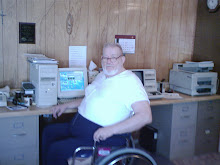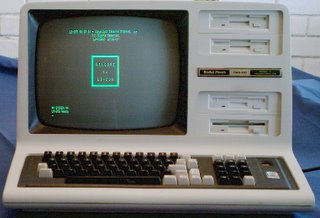Model 4 Memory Upgrade Installations
by Computer News 80
We are constantly getting request on “how to upgrade your model 4 or 4P of 4Ds memory to 128K
over the standard 64K that it was sold with.”
We are also constantly asked “how do I tell if my computer is a gate-array or a non-gate-array
computer.” So here we are once again with the explanation for all.
First, a Non-gate-array Model 4 desktop computer has three separate boards. Or at least two boards in
the back of the computer if the RS-232C or Serial Board was not installed. In many units that were
sold to school systems the serial board was left out. Also if the computer does not have any disk drives
in it then it only has one main board which is the main CPU (computer processing unit) or
motherboard.
The gate-array Model 4 and 4D desktop units have only one main CPU with all controller boards
combined into one.
All Model 4D computers were manufactured with gate-array boards installed.
The Model 4P has two types of boards, and in each case these boards are single boards, but it may be a
non-gate-array or it may a gate-array board. There is no way to tell which board is in your 4P without
opening it up and looking at the number that is stamped on the board.
Now how do we tell what it is if it is a Model 4 desktop unit, without opening the computer? If the
computer has the serial port RS-232C controller board installed you can easily tell what type of
computer it is from looking at the RS-232C connector on the bottom of the computer.
NON-GATE-ARRAY COMPUTERS
If the connector in figure 1 sticks straight down on the bottom of the computer in a vertical position,
where you would have to lift the computer up to insert a cable into it. Then it is a non-gate-array
computer.
GATE-ARRAY COMPUTERS
If the connector RS232 sticks straight out the back of the computer in a horizontal position, where
you would not have to lift the computer up to insert a cable into it. Then it is a gate-array computer.
Some Model 4 desktop computers and Model 4P portables were shipped having a letter “A” added to
the catalog number to indicate that it was a gate-array computer. However for some reason this label
didn’t get on many of the gate-array computers. And if your computer had been in the repair shop at
one time or another then a different main CPU could have been installed. So there is really no sure
way outside of the one above to tell if your computer is a gate-array or a non-gate-array type.
But to upgrade your computer to 128K of memory you will have to open the computer anyway. So if
you are in doubt open the computer and take a look before placing your order.
As many readers know we have been supplying an upgrade kit for some years for $12.95 plus
shipping. This kit consist of 8 memory chips and instructions and we always include a memory test
program on a disk so that the user can check the installation to be sure that every thing has been
installed properly.
The memory chips are not standard chips that you might pick up at your local electronics store today.
They must be chips that have a 128-refresh cycle, and they have not been manufactured for years. Our
source for these chips is a supplier who deals in surplus chips and we guarantee every chip that we
sell. Plus they are rated at 150 nanosecond, which is faster than the original chips in processing signals
than the original chips that Radio Shack installed.
If your computer is the non-gate-array type you will need a special PAL chip to install so that it will
recognize the additional memory. these PAL chips go into the original U72 location to replace the
small silver-looking shunt block that is there. These PAL chips are the last remaining stock
manufactured for Radio Shack and are an original part. They add an additional $8 to your upgrade cost
for a Model 4 non-gate-array computer.
THE FOLLING ARE INSTRUCTIONS ON HOW TO INSTALL THE MEMORY CHIPS.
MODEL 4 and 4D
MODEL 4 NON GRATE ARRAY VERSION
After removing the case and RF shield: Look for the 8 empty sockets (looking from the rear towards
the front) on the lower half of the right hand side of the motherboard. These will be labeled U85
through U92. Read section below on STATIC ELECTRICITY PRECAUTIONS. Install all 8 (16
pin) memory chips in the aforementioned empty sockets. Be certain to observe the pin indicator which
will be EITHER a “dimple” or a “notch” at one end of the chip. The end of the socket indicating
where pin 1 is will also have a “notch”. When you’ve accomplished this step, you are more than
halfway through.
Now, look at the bottom middle third of your motherboard. Look for the U72 identification marker.
Adjacent to the U72 marker is an IC socket, which has a “something” in it which does not look like all
the other IC’s. It has little “bands” running between the legs. This is called a shunt. It serves the
function of making connections required by the 64K version and is no longer needed after this
upgrade. Remove the shunt and insert the PAL chip from the “kit” (which is the 20-pin chip) in its
place. Note there is a notch on the end of the PAL chip that the label does not cover. when inserting
the PAL chip match up the notches of the socket and the PAL chip and gently press the PAL chip into
its socket.
This completes this version of installation. Do “MEMDISK”, run Double Duty, or run
“MEMTEST/CMD”.
MODEL 4 GATE ARRAY VERSION
After the case is opened and the RF shield is removed: Look for the 8 empty sockets, right hand side
middle of the motherboard. these are labeled U67 through U74. See section below on STATIC
ELECTRICITY PRECAUTIONS. Install all 8 memory chips in the aforementioned sockets. Be
certain to observe the pin indicator, which will be EITHER a “dimple” or a “notch” at one end of the
chip. The end of the socket indicating where pin 1 is will also have a “notch”. When you’ve
accomplished this step, you are more than halfway through.
Now, look at the bottom of the top third of the board. Approximately equal distant from either side, is
a capacitor labeled C39 which is adjacent to U33. Your motherboard will have either a small wire
(usually blue) * OR * three pins, of which the top two will be hidden by a black plug-on “jumper”.
Pull out on it and move it so the bottom two pins are hidden, that is to say move it away from C39.
On the motherboard which have the small blue wire connected it to the bottom of C39: Tin pin 16 with
a small amount of solder. This the sixth pin up from the bottom of U33 next to C39. Be very careful
you don’t short it with excess solder to any other pin. Remove the small wire from the bottom of C39
and solder it to pin 16, which is the one you just tinned. Again, be very careful NOT to short it to any
other pin.
This completes the gate-array Model 4 version. Do “MEMDISK”, run Double Duty, or run
“MEMTEST/CMD”.
MODEL 4P
MODEL 4P NON GATE ARRAY VERSION
After opening the case (see below): Have the card edge (50 pin I/O and the 34-pin printer) connectors
point AWAY from you. In the lower right hand quadrant there are 8 empty sockets. Install the 8 (16
pin) memory chips in the sockets remembering that pin end of the IC is either a “dimple” or a “notch”.
Insert the memory chips into the sockets, the dimple or notch end of the IC matching the “dimple” or
“notched” end of the socket.
In the approximate center of the motherboard, locate (jumper) pins labeled E11, E12, E13 which are
adjacent to U89. Move the jumper pins E12 and E13 to E11 and E12.
This completes the 4P-non gate-array version. Do “MEMDISK”, run Double Duty, or run
“MEMTEST/CMD”.
MODEL 4P GATE ARRAY VERSION
After opening the case (see below) : Have the card edge connectors (as in the previous) point away
from you. In the lower right hand quadrant there are 8 empty sockets as above. Install as above. In
4
the lower left-hand quadrant, adjacent to U106, find the jumper (pins) labeled E1, E2, E3. Move the
black jumper from E2 and E3 to E1 and E2.
This completes the 4P-gate array version. Do “MEMDISK”, run Double Duty, or run
“MEMTEST/CMD”.
MODEL 4 CASE REMOVAL
1) Remove the three black machine screws located under the keyboard.
2) Remove the two machine screws located in a recess on either side just forward of the
Brightness/contrast controls. These are the only machine screws holding the case together. Be
SURE you put them back in the same place.
3) Remove the black sheetmetal screw on the back top center. (You might not have this one.)
4) Remove the remaining sheetmetal screws, two on the left toward the rear, one on the right rear
(may be under the warranty sticker) and two remaining screws: one near the cassette connector, the
other near the 50 pin I/I card edge connector. When you replace the screws, be very careful to put
the sheetmetal screws where they belong.
5) This step is CRITICAL. With the monitor screen facing you: Lift up SLIGHTLY, PULL
FORWARD. The CRT (MONITOR) tube “neck” can catch and break on the upright chassis. USE
CAUTION. Tilt to the left after clearing the CRT “neck”, and lay top on its left side. Peek
through the floppy drive holes.
6) Look at the rear of the unit. Remove the RF shield by removing all the sheetmetal screws holding
it in place. Be sure to replace as this reduces radio/TV interference.
7) Re-assembly: replace top pulling forward so as NOT to damage CRT. Reverse the rest of the
procedure.
MODEL 4P CASE REMOVAL
1) Remove (face) cover.
2) Set the keyboard aside and place unit face down on a soft surface.
3) Remove two white screws on left side and right side.
4) Lift the handle and remove the two screws there. Lift outer case off.
5) Remove the 4 or 5 screws on both sides of the lower “pan”, on which the motherboard is mounted.
6) Remove the floppy drive connector from its connector.
7) Remove the “pan”, note that on the left-hand front there are three connectors, carefully remove,
noting orientation.
8) Reverse procedure for re-assembly. Be careful that all connectors are re-installed correctly.
STATIC ELECTRICITY PRECAUTIONS.
Be sure that you have discharged any body static electricity before working on your computer. To do
this touch any grounded metal or work with your shies off on a non-wool carpet or floor.
COMPUTER NEWS 80
PO Box 50127
Casper WY 82605-0127
Phone: (307)265-6483; Mon-Fri, 8AM-5PM Mountain Time
HAPPY COMPUTING

